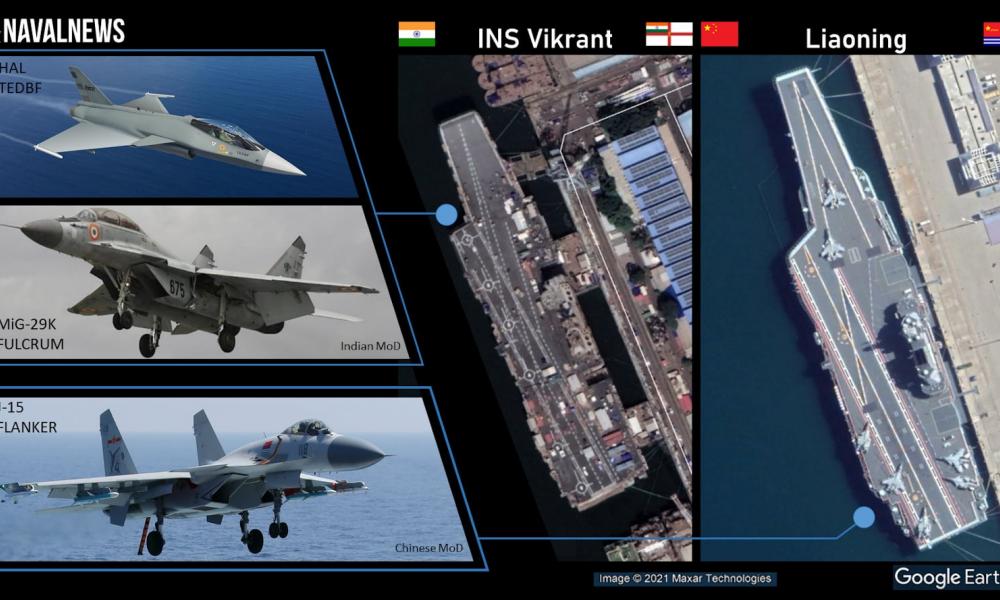The Chinese Navy is rapidly expanding its aircraft carrier fleet, with two in service and at least one more under construction. And while still new to the game, their experience of operating carriers is growing all the time. Regional rival India has a much longer tradition of carrier aviation, but fewer and smaller carriers. The first indigenous aircraft carrier, Vikrant, could keep India competitive however, according to navalnews.com
The Indian Navy’s first indigenous aircraft carrier, INS Vikrant, is expected to start sea trials soon. She will be India’s second aircraft carrier joining the Russian built INS Vikramaditya. When she joins the fleet she will be a key component to India’s ability to face China’s growing naval capabilities.
The Indian Navy has a strong tradition of carrier aviation. It has operated fixed-wing aircraft carriers continuously since 1957, surpassed only by France the US. Yet the new carrier represents a step forward, both for the navy and for indigenous industry.
The Chinese Navy on the other hand started operating carriers just under 10 years ago. We should not underestimate the lessons learned during this time, but China is still some years away from realizing its full carrier potential. However with at least three large carriers in service or under construction, it is a question of ‘when’ rather than ‘if’. Their third carrier, which is under construction in Shanghai, will be comparable in size to the US Navy’s Ford Class super-carriers.
At 45,000 tons the Vikrant will be around 67% the size of China’s existing aircraft carriers, which displace around 65,000 tons. But her compact dimensions belie capabilities which are overall quite comparable to China’s first two carriers, the Liaoning (CV-16) and Shandong. And her deck area is around 85% of the size.
Although the construction of the Indian and Chinese ships overlaps, in many respects the Indian carrier is a generation newer in design. Design of Vikrant started in 1999 while the Chinese ships are rooted in 1970s Soviet technology. Vikrant was launched in August 2013 and has been fitting out in Kochi since then.
The Chinese ships however are essentially Soviet designed Admiral Kuznetsov class ships. Liaoning in fact was laid down in 1985 and only sold to China, ostensibly for scrap, in 1998. She entered service in 2012. Shandong was built to the same overall design (with some modifications) and entered service in 2019.
The differences are most telling under the deck however. The Chinese ships use traditional steam turbines while Vikrant uses a more modern gas turbine arrangement.
Both Liaoning and Shandong are already operational however. While China’s experience in aircraft carrier operations is much younger than India’s, it is now more than 8 years since Liaoning was commissioned. She is currently exercising off Qingdao in the Yellow Sea.
Air Wings
The Chinese carrier’s main combat aircraft is the Shenyang J-15 Flanker-D, a reverse-engineered copy of the Sukhoi Su-33. Like other Chinese Flanker derivatives the J-15 is equipped with a range of Chinese air-air missiles including the PL-12 beyond visual range missile. They can also carry anti-ship missiles and land-attack missiles.
The Flanker is a large aircraft however. India has opted for the mid-sized MiG-29K Fulcrum two-seat carrier-borne fighter instead. Consequently, despite the size difference, the vessels have a similar air wing size.
The Indian Navy is looking at a more modern fighter to replace the Fulcrums. The main contender is the Hal TEDBF (Twin Engine Deck Based Fighter). This compact canard design is hoped to fly in 5 years time. In the meantime the Indian Navy may order a smaller number of interim carrier fighters with the Boeing Super Hornet and Dassault Rafale as talked about contenders.
Both the country’s carriers are expected to have organic airborne early warning (AEW) capabilities. The Indian Navy via the Ka-31 Helix helicopter and the Chinese with the Z-18J helicopter. Helicopter based early warning may greatly increase air defense and situational awareness of the respective carrier battle groups but it is inherently more limited than fixed-wing types.
China has developed a fixed wing AEW plane, the Xi’an KJ-600. This is closely analogous to the carrier-borne E-2D Hawkeye in American and, soon, French Navy service. However it is not expected to serve aboard Liaoning or Shandong because they lack the catapult launch system. China’s third carrier is expected to have catapults for this aircraft however.
The third carrier, which is known to be larger than the Liaoning and Shandong, is likely to bring in new naval fighters too. China is capable of developing 5 generation aircraft so it may only be a matter of time before the J-15ds are replaced. It is likely that the new type would also be carried by the first two carriers.
Outlook
More countries are operating large aircraft carriers today than in the past with the biggest growth in Asia. Increasingly capable smaller carriers, similar to India’s previous ones, are cropping up. New operators will include Japan and South Korea. Flying F-35s these will be very potent. And France and the United Kingdom are both pivoting their carrier operations towards Asia.
India will mostly be eying China’s growing naval might however. It is unlikely that India will ever operate more carriers than China going forward, those days have passed. But with two carriers the gap will be manageable. Especially as China is unlikely to commit all its carriers to the Indian Ocean in the event of a conflict. With investment in aircraft, India can maintain a strong position in the carrier game.

Κόσμος
Ενημερώθηκε στις:
Indian Navy’s First Indigenous Aircraft Carrier Vikrant Catching Up To China

Ακολουθήστε το Πενταπόσταγμα στο Google news













